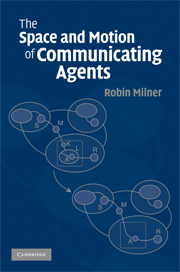Prologue
Published online by Cambridge University Press: 05 August 2012
Summary
The informatic challenge
Computing is transforming our environment. Indeed, the term ‘computing’ describes this transformation too narrowly, because traditionally it means little more than ‘calculation’. Nowadays, artifacts that both calculate and communicate pervade our lives. It is better to describe this combination as ‘informatics’, connoting not only the passive stuff (numbers, documents, …) with which we compute, but also the activity of informing, or interacting, or communicating.
The stored-program computer, which sowed the seeds of this transformation 60 years ago, is itself a highly organised informatic engine specialised to the task of calculation. Computers work by internal communication among their parts; noone expected that, within half a century, most of their work – bar highly specialised applications – would involve external communication. But within 25 years arose networks of interacting computers; the control of interaction then became a prime concern. Interacting systems, such as the worldwide web or networks of people with phones, are now commonplace; software takes part in them, but most prominent is communication, not calculation.
These artifacts will be everywhere. They will control driverless motorway traffic, via communication among sensors and effectors at the roadside and in vehicles; they will monitor and treat our health via communication between devices installed in the human body and software in hospitals. Thus the term ‘ubiquitous computing’ represents a vision that is being realised. In 1994 Mark Weiser, a pioneer of this vision, wrote
Populations of computing entities will be a significant part of our environment, performing tasks that support us, and we shall be largely unaware of them.
- Type
- Chapter
- Information
- The Space and Motion of Communicating Agents , pp. ix - xxPublisher: Cambridge University PressPrint publication year: 2009

